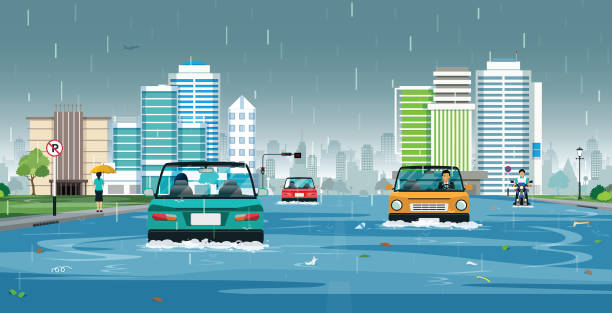It’s raining, Great! Rain doesn’t change your daily meetings, your commute to the airport or to the office to prepare for the day. However one thing is certain; rain means your commute to wherever you need to go just got longer, much longer. How do you get to your destination safely driving in these wet conditions? You’re in a hurry to get to your destination in the rain with other drivers rushing to do the same too.
To drive safely in the rainy season requires a special approach, and one of them is by reducing the speed of the car you are driving. The rate of driving accidents when it rains is indeed very high due to several factors.
When the road conditions are pouring rain, the road surface will become slippery. To stay safe driving in the rain, make sure you drive at a low speed and drive slowly so that the tire grooves are in direct contact with the asphalt so that the tire grip is better.
Excessive car speed can also make accidents challenging to avoid. Tire contact will be lost with slippery road or asphalt conditions, especially with too rough maneuvers. Tires that are bald or unfit for use can also be a factor in accidents.
To avoid accidents in a rainy position, you have to drive carefully and slow down when driving the car. By reducing the speed in driving, the car will be easier to control.
If the natural conditions when driving are raining, you should not drive a car with a speed of more than 40 km per hour, and you can drive a car at a speed of 10 km per hour. If driving on a toll road in heavy rain you can speed up around 50 to 60 km per hour. Make sure you drive the car according to traffic conditions.
At speeds as low as 35 mph, new tires can still lose some contact with the roadway. To reduce chances of hydroplaning, drivers should slow down, avoid hard braking or turning sharply and drive in the tracks of the vehicle ahead of you.
Now that you are maintaining a safe distance between yourself and the car in front of you and you’re watching your speed, what’s next?
Visibility
The second thing you should check is visibility of your vehicle by other drivers. Depending on the intensity of the thunder storm or rainfall visibility might be a very real challenge. To increase your visibility to other drivers you should always turn on your headlights. Technically it is recommended that you turn on your headlamps in any condition that obscures visibility. Headlamps become a bigger necessity if the intensity of rain is so much so that you have less than 1000 feet of visibility. In addition it is Texas law. Furthermore if your wipers are on you should also turn on your headlamps. In some cases automobile manufacturers make cars with running daylights (headlamps that stay on always).
Cruise Control
As you would imagine, reaction time in wet conditions are even more important than they are normally. Car manufacturers from the last decade have made one feature a mainstay in everything from base to fully loaded options on cars; cruise control. Cruise control takes away your ability to react as quickly as possible, leaving your car in auto-mode more-or-less for longer than you would like it to be in case of an emergency. The cruise control feature also increases the possibility of hydroplaning and ultimately losing control of your vehicle in wet conditions.
Everyone will have to deal with hydroplaning at some point or other, in wet road conditions. Do you know how to respond if your car begins to hydroplane?
Hydroplaning, Regaining Control
Safety in wet road conditions should also include how to react in case of incidents like hydroplaning. If you begin to lose control of your vehicle in wet conditions you should first avoid slamming on the brake. It may be easier said than done but it helps. Slamming on the brake throws the vehicle’s balance off even further and make re-establishing control of the wheel, much more difficult. When losing control you should remain as observant as possible and steer the car in the direction you want it to go.
In conclusion, everyone should be vigilant and pay attention when operating a vehicle. That vigilance should be increased in wet inclement conditions. Slowing down is your first line of defense, your second is to establish your visibility to other drivers and lastly to avoid the cruise control feature.







